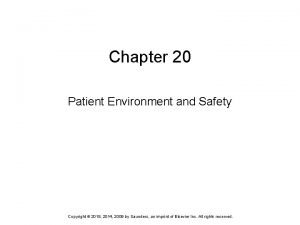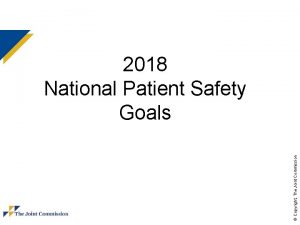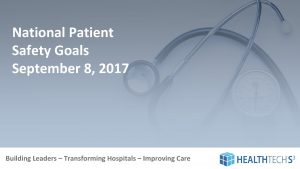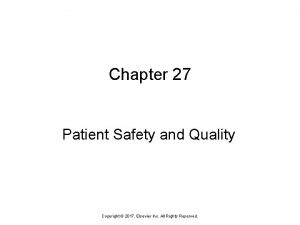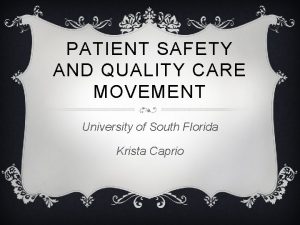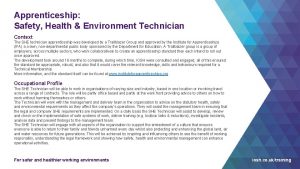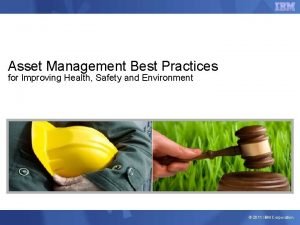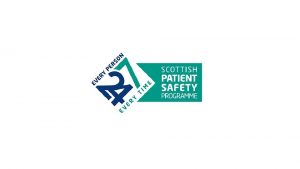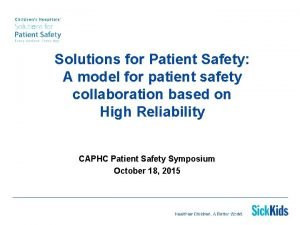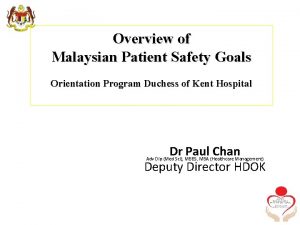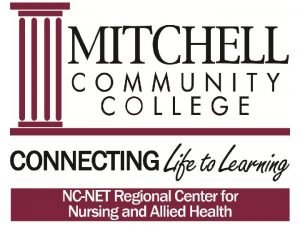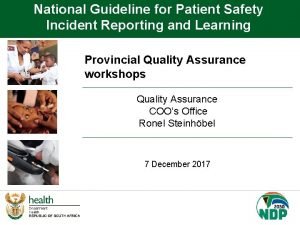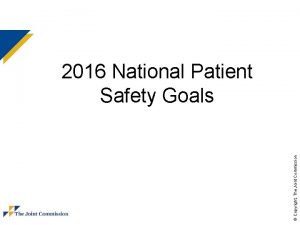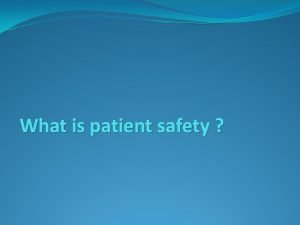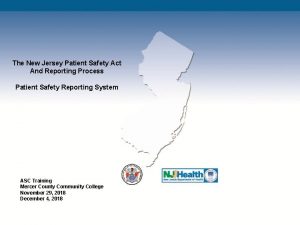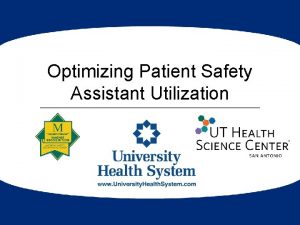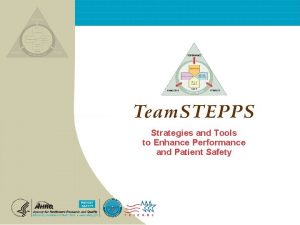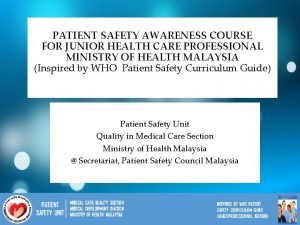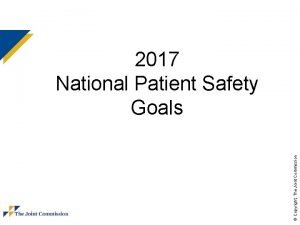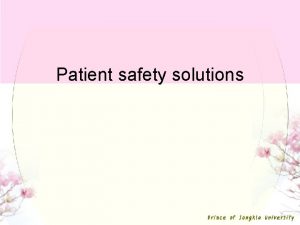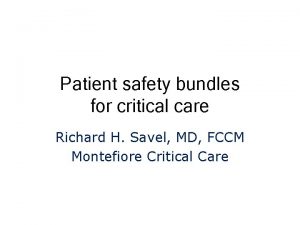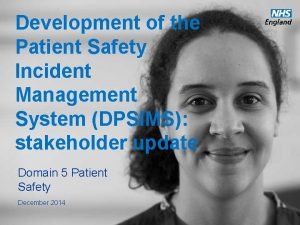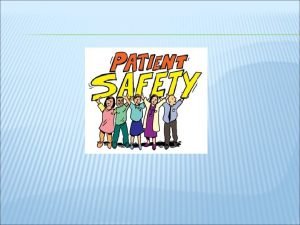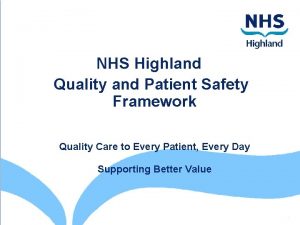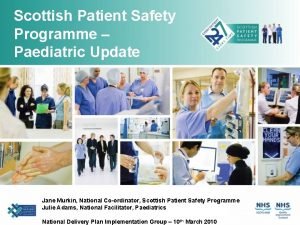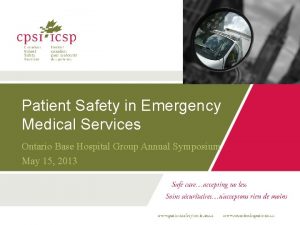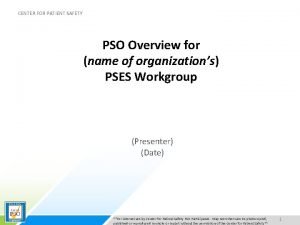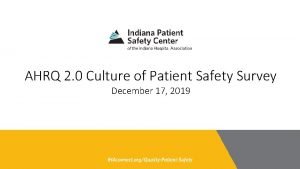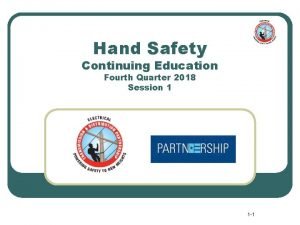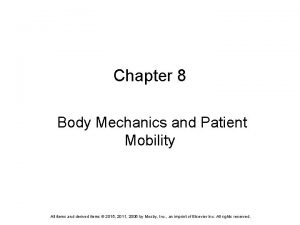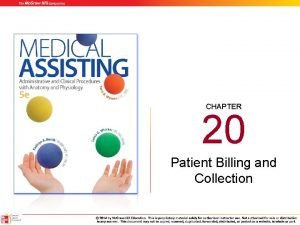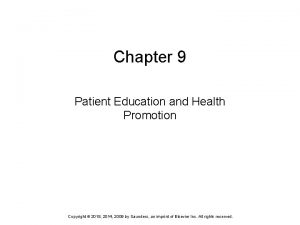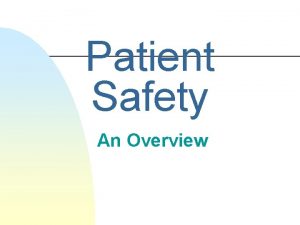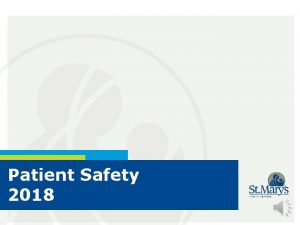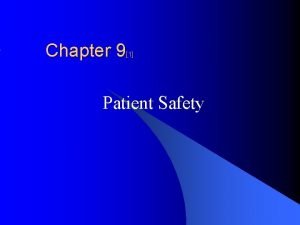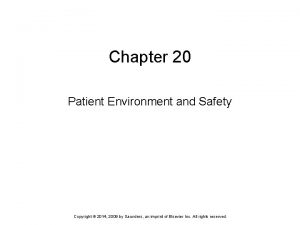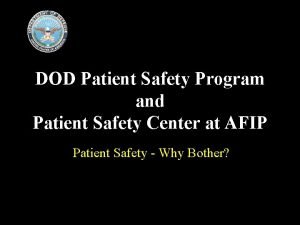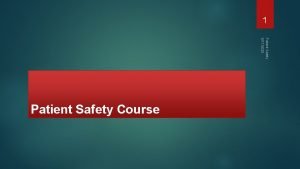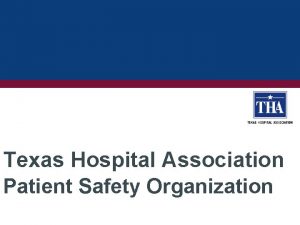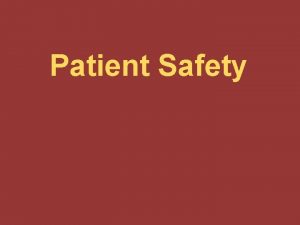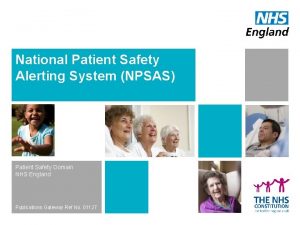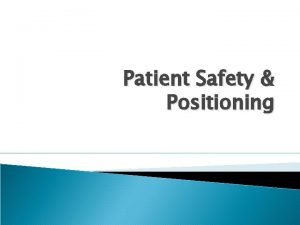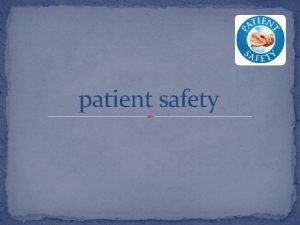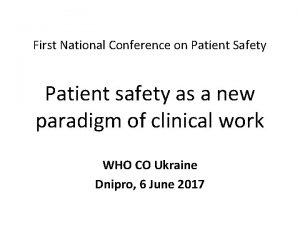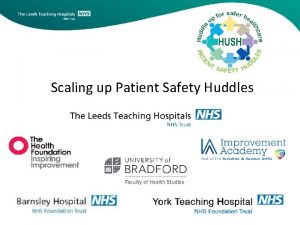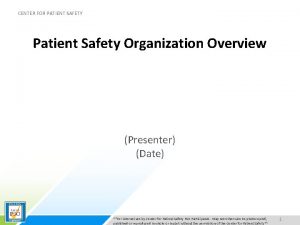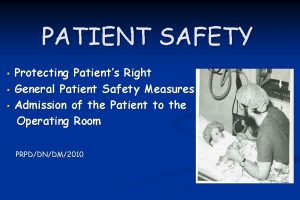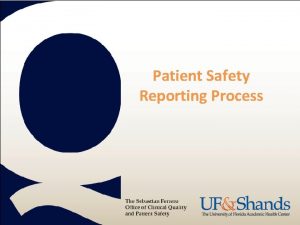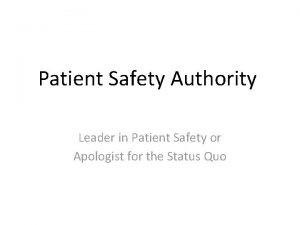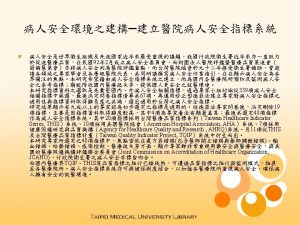Chapter 20 Patient Environment and Safety Copyright 2018








































- Slides: 40

Chapter 20 Patient Environment and Safety Copyright © 2018, 2014, 2009 by Saunders, an imprint of Elsevier Inc. All rights reserved.

Lesson 20. 1 Preparing a Safe Environment Theory 1) Discuss nursing responsibilities for environmental management. 2) Identify common noises in health care facilities and ways to minimize their effects on patients. 3) Explain the importance of neatness and order in the patient’s environment. Copyright © 2018, 2014, 2009 by Saunders, an imprint of Elsevier Inc. All rights reserved.

Lesson 20. 1 Preparing a Safe Environment Clinical Practice 1) Discuss how the health care facility’s environment affects your patient. 2) Using correct technique, make an unoccupied an occupied bed. Copyright © 2018, 2014, 2009 by Saunders, an imprint of Elsevier Inc. All rights reserved.

Factors Affecting the Environment Florence Nightingale wrote about environmental factors that needed to be controlled more than a century ago Ø Ø Ø Ø Temperature Ventilation and humidity Lighting Odor control Noise Interior design Neatness Privacy Copyright © 2018, 2014, 2009 by Saunders, an imprint of Elsevier Inc. All rights reserved.

Environmental Factors Temperature Infants and older adults require warmer rooms Ø Room temperature should be between 68°and 74°F Ø Operating rooms and critical care areas slightly cooler Ø Ventilation—supplying a room with fresh air continually Fans are discouraged because of infection control concerns Ø Do not open windows in the hospital Ø Copyright © 2018, 2014, 2009 by Saunders, an imprint of Elsevier Inc. All rights reserved.

Environmental Factors (cont’d) Humidity—amount of moisture in the air From 30% to 50% is comfortable Ø Too little humidity will dry respiratory passages Ø Lighting Should be adequate to perform tasks and prevent accidents and injury Ø Should be bright enough to see, but soft enough to prevent sharp shadows Ø Patient should be able to control lights independently Ø Copyright © 2018, 2014, 2009 by Saunders, an imprint of Elsevier Inc. All rights reserved.

Environmental Factors (cont’d) Odor Ø Ø Ø Ø To control odors: Empty and rinse bedpans, bedside commodes, and urinals promptly Dispose of dressings and used equipment Nothing odorous should be placed in trash in a patient’s room Avoid the sources of odors Remove old flowers and stagnant water Perfumes, scented lotions, or scented cosmetics should not be worn in patient areas Copyright © 2018, 2014, 2009 by Saunders, an imprint of Elsevier Inc. All rights reserved.

Environmental Factors (cont’d) Noise The main source in a hospital is people Ø Patient may experience sensory overload from noise Ø Soft, pleasant background music can mask other sounds and promote relaxation Ø Reduce noise by: • Avoiding long conversations in the hallways • Encouraging staff to speak in lowered voices • Avoiding jokes and laughter at the nurses’ station • Answering alarms on IV pumps and equipment promptly Ø Copyright © 2018, 2014, 2009 by Saunders, an imprint of Elsevier Inc. All rights reserved.

Environmental Factors (cont’d) Interior design Patients’ rooms and public areas look more like a hotel now as opposed to the stark white of the past Ø Rooms have draperies and colorful bedspreads Ø These changes are to promote comfort by providing a homelike environment for the patient Ø Copyright © 2018, 2014, 2009 by Saunders, an imprint of Elsevier Inc. All rights reserved.

Environmental Factors (cont’d) Neatness Straighten the patient’s unit after making the bed and whenever appropriate Ø Remove trays and dishes promptly after meals Ø Keep the over-the-bed table clear of unnecessary clutter or equipment Ø Copyright © 2018, 2014, 2009 by Saunders, an imprint of Elsevier Inc. All rights reserved.

Environmental Factors (cont’d) Privacy: essential for patient’s well-being Always knock gently and identify yourself before entering the room Ø In multiple-patient rooms, close the curtain around the patient for personal tasks such as using a bedpan and bathing Ø Post a sign on the door informing others of such tasks to discourage them from entering the room Ø Copyright © 2018, 2014, 2009 by Saunders, an imprint of Elsevier Inc. All rights reserved.

Patient Units Beds Usually have a firm mattress covered with a material that allows easy cleaning between patients; side rails should not present a hazard Ø May use an overlay to prevent pressure ulcer formation Ø Always lock wheels on a bed when not moving it and leave it in the low position when not performing a procedure on a patient Ø Copyright © 2018, 2014, 2009 by Saunders, an imprint of Elsevier Inc. All rights reserved.

Patient Units (cont’d) Unoccupied bed Ø Occupied bed Ø Made when the patient is out of bed in the chair or out of the room for a diagnostic procedure or therapy Made only if the patient absolutely cannot be out of bed Bed linens should be neat, orderly, and free from wrinkles Copyright © 2018, 2014, 2009 by Saunders, an imprint of Elsevier Inc. All rights reserved.

Question 1 Florence Nightingale described six elements of environment. They are: 1) 2) 3) 4) temperature, ventilation, humidity, lighting, odor, and noise. temperature, ventilation, safety, lighting, odor, and noise. temperature, circulation, vaporizers, lighting, sensory and perception, odor, and privacy. temperature, ventilation, neatness, lighting, privacy, and safety. Copyright © 2018, 2014, 2009 by Saunders, an imprint of Elsevier Inc. All rights reserved.

Question 2 Which of the following is not an appropriate guideline for bed-making? 1) 2) 3) 4) Check to make sure the bed wheels are locked. An occupied bed is made only when the patient cannot be out of bed. Unfold linens onto the bed. Place soiled linens on the floor. Copyright © 2018, 2014, 2009 by Saunders, an imprint of Elsevier Inc. All rights reserved.

Lesson 20. 2 Prevention, Containment, and Protection Theory 4) Describe methods to prevent mechanical and thermal accidents and injury in health care facilities and the home. 5) Discuss the various forms of bioterrorism, safety measures to be taken, signs and symptoms of agents used, and measures to treat or contain the threat. 6) Discuss the principles for using protective devices. 7) Demonstrate knowledge of the legal implications of using protective devices. Copyright © 2018, 2014, 2009 by Saunders, an imprint of Elsevier Inc. All rights reserved.

Lesson 20. 2 Prevention, Containment, and Protection Clinical Practice 3) Explain, according to your facility’s procedures, how to clean up a biohazard spill. 4) Discuss your clinical facility’s response plan to a bioterrorism threat. 5) Given an emergency scenario, practice triaging the victims. 6) Correctly apply an extremity immobilizer. Copyright © 2018, 2014, 2009 by Saunders, an imprint of Elsevier Inc. All rights reserved.

Safety A primary concern when caring for your patients Safety is needed to prevent accidents and possible injuries to patients, visitors, and health care personnel Copyright © 2018, 2014, 2009 by Saunders, an imprint of Elsevier Inc. All rights reserved.

Safety (con’t) Most common patient accidents/incidents: Falls Ø Burns Ø Cuts and bruises Ø Fights with others Ø Loss of possessions Ø Choking Ø Electrical shock Ø Review Box 20 -3 for ways to promote patient safety Copyright © 2018, 2014, 2009 by Saunders, an imprint of Elsevier Inc. All rights reserved.

Falls Three common factors Impaired physical mobility Ø Altered mental status Ø Sensory and/or motor deficits Ø Patients at risk for falls may need a leg or bed alarm Ø Sense a change in position or pressure and sound an alarm to alert health care workers or family members that patients are attempting to get out of bed or a chair Copyright © 2018, 2014, 2009 by Saunders, an imprint of Elsevier Inc. All rights reserved.

Burns Prevention includes protecting the patient from thermal injury Can be caused by hot or cold materials Diabetic patients, paralyzed patients, or patients with altered mental awareness at risk for burns The nurse should check the temperature of liquids before giving them to the patient The nurse should caution the patient about sleeping on a heating pad or a cold pack Inspect electrical cords for frayed or broken areas that may cause sparks or fires Copyright © 2018, 2014, 2009 by Saunders, an imprint of Elsevier Inc. All rights reserved.

Smoking Banned in most health care facilities Some long-term care agencies allow smoking in designated areas Carefully supervise the patient who wants to smoke and is sedated, confused, or irrational Smoking is never allowed when oxygen is in use because a spark could cause a fire Any equipment that might cause a spark is also prohibited near oxygen Copyright © 2018, 2014, 2009 by Saunders, an imprint of Elsevier Inc. All rights reserved.

Fire Know and be familiar with your institution’s fire regulations Know the location of the fire extinguishers, fire alarms, and escape routes, and how to notify the telephone operator of a fire in your area Should a fire occur, you must Rescue any patients in immediate danger by removing them from the area Ø Activate the fire alarm system Ø Contain the fire by closing doors and windows Ø Extinguish flames with an appropriate extinguisher Ø Copyright © 2018, 2014, 2009 by Saunders, an imprint of Elsevier Inc. All rights reserved.

Nursing Actions to Promote Patient Safety in the Health Care Facility Orient the patient to the unit on admission Assess patient’s gait and risk for falling on admission Evaluate patient’s drug regimen for side effects that increase the risk for falling Keep bed in low position when not giving direct care Toilet the patient on a regular schedule Copyright © 2018, 2014, 2009 by Saunders, an imprint of Elsevier Inc. All rights reserved.

Nursing Actions to Promote Patient Safety in the Health Care Facility(cont’d) Lock the wheels on the bed Provide a night-light for going to the bathroom Encourage the use of nonskid slippers Answer call lights promptly Tell the patient when you will next check in Encourage the use of grab bars Copyright © 2018, 2014, 2009 by Saunders, an imprint of Elsevier Inc. All rights reserved.

Nursing Actions to Promote Patient Safety in the Health Care Facility(cont’d) Place high-risk patients in a room close to the nurses’ station Be sure the patient’s call bell is within reach Stay with confused or unsteady patients when they are up Provide diversionary activities for confused patients Make sure wheelchair brakes are locked Copyright © 2018, 2014, 2009 by Saunders, an imprint of Elsevier Inc. All rights reserved.

Nursing Actions to Promote Patient Safety in the Home Place a nonskid bath mat in the tub or shower Use night-lights to help patient find the bathroom Suggest installation of grab bars Install door buzzers or bed alarms Maintain the same furniture arrangement Encourage removal of extension cords Caution the patient about toys and animals Provide appropriate community resources Copyright © 2018, 2014, 2009 by Saunders, an imprint of Elsevier Inc. All rights reserved.

Biohazards A biologic agent, chemical, or condition that can be harmful to a person’s health OSHA publishes specific guidelines for labeling, handling, cleaning spills, and disposing of these materials Material safety data sheet (MSDS) consulted for recommended methods of storage, labeling, handling spills, and disposal Copyright © 2018, 2014, 2009 by Saunders, an imprint of Elsevier Inc. All rights reserved.

Bioterrorism and Other Terrorism Agents Bioterrorism: the release of pathogenic microorganisms into a community to achieve political and/or military goals Chemical terrorism: use of certain compounds to cause destruction to achieve political and/or military goals Ø Pulmonary agents, cyanide agents, nerve agents, vesicants, and incapacitating agents Radioactive substances attached to an explosive device (a “dirty bomb”) disperse radiation Copyright © 2018, 2014, 2009 by Saunders, an imprint of Elsevier Inc. All rights reserved.

Common Diseases Spread Through Bioterrorism Anthrax Botulism Ebola virus Lassa fever Plague Ricin Smallpox Tularemia Copyright © 2018, 2014, 2009 by Saunders, an imprint of Elsevier Inc. All rights reserved.

Decontamination Staff must wear masks and protective clothing that are impervious to chemicals and cover all skin surfaces Military mission-oriented protective posture (MOPP) suits may be used A chemical mask with filtered respirator must be worn with the suit Copyright © 2018, 2014, 2009 by Saunders, an imprint of Elsevier Inc. All rights reserved.

Triage and Treatment Assessed and labeled according to the priority of care as “immediate, ” “delayed, ” “minimal, ” or “expectant” Treatment based on type of agent to which the patient was exposed and degree of exposure Antibiotics used for some biologic agents Ø Antidotes used for some of the chemicals and poisonous gases Ø Otherwise, treatment is directed at supporting organ function while the body tries to recover Ø Copyright © 2018, 2014, 2009 by Saunders, an imprint of Elsevier Inc. All rights reserved.

Poisons A substance that when ingested inhaled, absorbed, applied, injected, or developed within the body, may cause functional or structural disturbances Treatments and antidotes obtained from a poison control center or listed on some containers In the event of a suspected poisoning: Ø Contact the poison control center; have the label of the product in front of you and be ready to report: • • Name of the product Patient’s age Amount you believe is involved Any symptoms involved Copyright © 2018, 2014, 2009 by Saunders, an imprint of Elsevier Inc. All rights reserved.

Protective Devices Behavioral indications Psychiatric setting Ø Sudden change in mental status/behavior Ø Nonbehavioral indications Ø Continuation of medical treatments It is your responsibility to be aware of and follow the regulations in your facility and area Copyright © 2018, 2014, 2009 by Saunders, an imprint of Elsevier Inc. All rights reserved.

Legal Implications of Using Protective Devices Federal and local laws mandate: Protect the patient from physical and mental abuse and from physical and chemical restraints Ø Except those that are authorized by a physician, in writing, for a specified and limited period of time, or that are needed in an emergency situation Ø Copyright © 2018, 2014, 2009 by Saunders, an imprint of Elsevier Inc. All rights reserved.

Alternatives to Protective Devices The goal is to move to a less-restrictive environment Health care workers are encouraged to find alternatives to the use of protective devices Family and friends of a patient who is confused can be encouraged to sit with the patient to promote safety Copyright © 2018, 2014, 2009 by Saunders, an imprint of Elsevier Inc. All rights reserved.

Principles Related to the Use of Protective Devices Protective devices must help the patient or be needed to continue medical therapy Use the least amount of immobilization needed For all restrictive devices there must be a written order. As soon as the device is no longer needed, the physician must be notified Apply the device snugly but not so tightly as to interfere with blood circulation or nerve function Device must be removed and patient’s position changed every 2 hours. Active or passive exercises for immobilized joints and muscles Copyright © 2018, 2014, 2009 by Saunders, an imprint of Elsevier Inc. All rights reserved.

Question 3 Most agencies use the RACE acronym to respond to a fire because it is easy to remember. Which letter is correctly identified? 1) 2) 3) 4) R—run away from the immediate danger A—activate the fire alarm system C—call 911 E—evacuate Copyright © 2018, 2014, 2009 by Saunders, an imprint of Elsevier Inc. All rights reserved.

Question 4 Melanie is working in the emergency room. Her patient is vomiting and has diarrhea, a loss of appetite, skin damage, and the potential for seizures, coma, or death. The patient informs Melanie that he was exposed to a high dose of radiation in a short period. What does this sound like? 1) 2) 3) 4) Anthrax Botulism Acute radiation sickness Radiation contamination Copyright © 2018, 2014, 2009 by Saunders, an imprint of Elsevier Inc. All rights reserved.

Question 5 Darby is a nurse working in a long-term care facility. She needs to use a protective device on her patient to ensure safety. When applying protective devices, it is important to remember all of the following except: 1) 2) 3) 4) try all alternative methods first. you should be able to easily fit your index and middle fingers between the patient and the device. secure the ties of a protective device to a movable part of the bed frame. at least every 2 hours, remove the device and provide passive range-of-motion exercises. Copyright © 2018, 2014, 2009 by Saunders, an imprint of Elsevier Inc. All rights reserved.
 Chapter 20 patient environment and safety
Chapter 20 patient environment and safety 2018 national patient safety goals
2018 national patient safety goals National patient safety goal 6
National patient safety goal 6 A nurse floats to a busy surgical unit
A nurse floats to a busy surgical unit Copyright © 2018
Copyright © 2018 Copyright © 2018 all rights reserved
Copyright © 2018 all rights reserved Patient 2 patient
Patient 2 patient Dada la siguiente secuencia rusia 2018 rusia 2018
Dada la siguiente secuencia rusia 2018 rusia 2018 Patient safety and quality care movement
Patient safety and quality care movement She technician apprenticeship
She technician apprenticeship Maximo health safety and environment manager
Maximo health safety and environment manager Maximo health safety and environment manager
Maximo health safety and environment manager Environment of business finance
Environment of business finance Scottish patient safety programme
Scottish patient safety programme Solutions for patient safety
Solutions for patient safety Malaysia patient safety goal
Malaysia patient safety goal National patient safety goals 2012
National patient safety goals 2012 Patient safety incident report form
Patient safety incident report form Learn from patient safety events
Learn from patient safety events National safety goals 2016
National safety goals 2016 Patient safety definition
Patient safety definition Nj patient safety act
Nj patient safety act Patient sitter algorithm
Patient sitter algorithm Dod patient safety program
Dod patient safety program Sue sheridan patient safety
Sue sheridan patient safety 13 malaysian patient safety goals
13 malaysian patient safety goals National patient safety goals 2017
National patient safety goals 2017 Patient safety solutions
Patient safety solutions Ihi care bundles
Ihi care bundles Safety incident management system
Safety incident management system 2013 hospital national patient safety goals
2013 hospital national patient safety goals Patient safety goals
Patient safety goals National patient safety framework
National patient safety framework Jane murkin
Jane murkin Canadian patient safety officer course
Canadian patient safety officer course Patient safety evaluation system
Patient safety evaluation system Ahrq patient safety survey
Ahrq patient safety survey Hand safety presentation 2018
Hand safety presentation 2018 Neurovascular assessment includes
Neurovascular assessment includes Chapter 20 patient collections and financial management
Chapter 20 patient collections and financial management Chapter 9 patient education and health promotion
Chapter 9 patient education and health promotion
